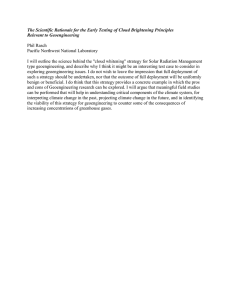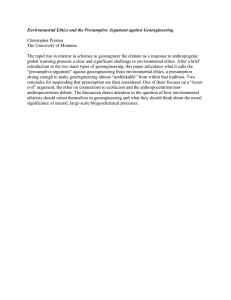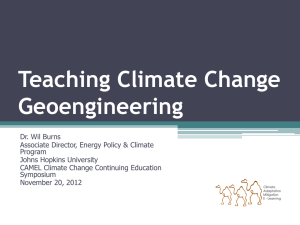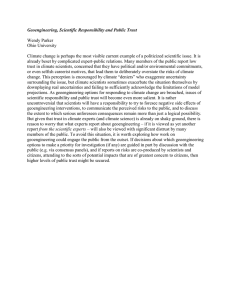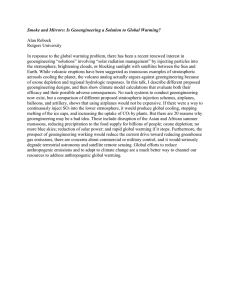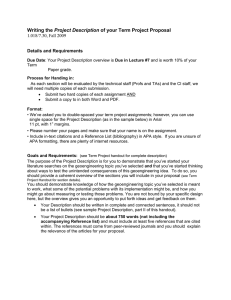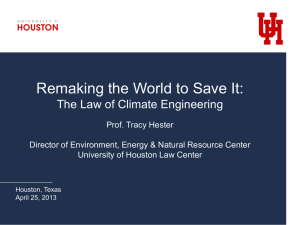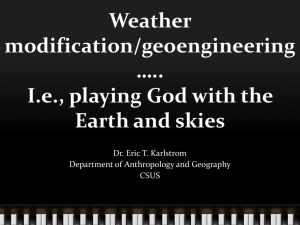Geo-engineering the climate: the troubling rise of intervention as an alternative climate policy Transcript
advertisement
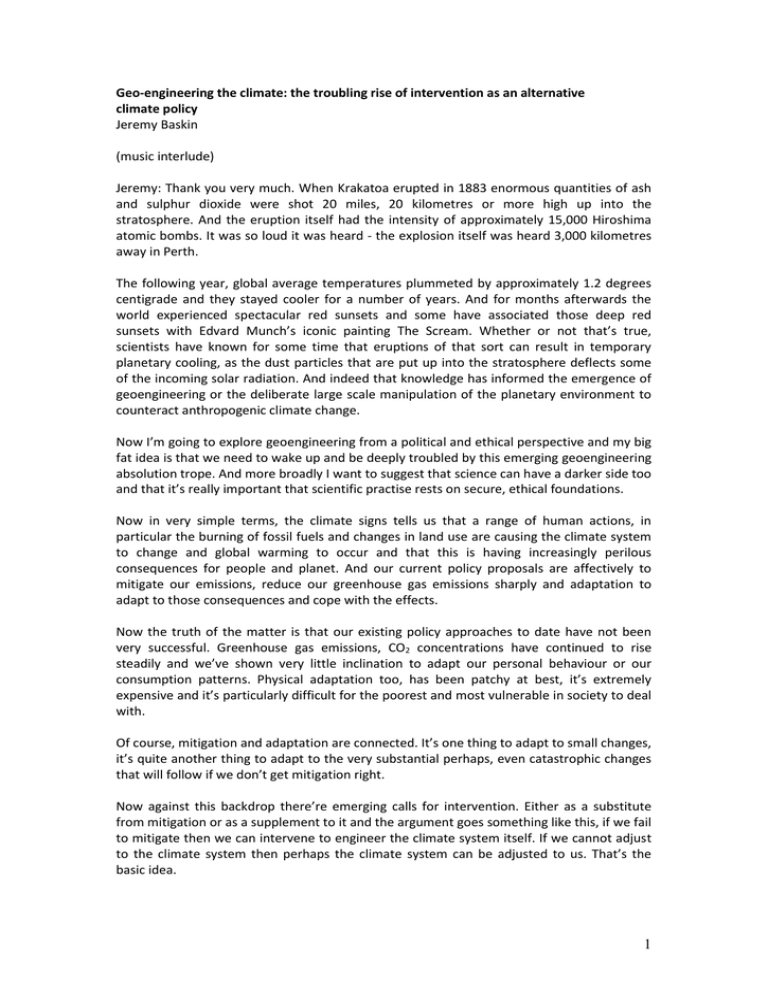
Geo-engineering the climate: the troubling rise of intervention as an alternative climate policy Jeremy Baskin (music interlude) Jeremy: Thank you very much. When Krakatoa erupted in 1883 enormous quantities of ash and sulphur dioxide were shot 20 miles, 20 kilometres or more high up into the stratosphere. And the eruption itself had the intensity of approximately 15,000 Hiroshima atomic bombs. It was so loud it was heard - the explosion itself was heard 3,000 kilometres away in Perth. The following year, global average temperatures plummeted by approximately 1.2 degrees centigrade and they stayed cooler for a number of years. And for months afterwards the world experienced spectacular red sunsets and some have associated those deep red sunsets with Edvard Munch’s iconic painting The Scream. Whether or not that’s true, scientists have known for some time that eruptions of that sort can result in temporary planetary cooling, as the dust particles that are put up into the stratosphere deflects some of the incoming solar radiation. And indeed that knowledge has informed the emergence of geoengineering or the deliberate large scale manipulation of the planetary environment to counteract anthropogenic climate change. Now I’m going to explore geoengineering from a political and ethical perspective and my big fat idea is that we need to wake up and be deeply troubled by this emerging geoengineering absolution trope. And more broadly I want to suggest that science can have a darker side too and that it’s really important that scientific practise rests on secure, ethical foundations. Now in very simple terms, the climate signs tells us that a range of human actions, in particular the burning of fossil fuels and changes in land use are causing the climate system to change and global warming to occur and that this is having increasingly perilous consequences for people and planet. And our current policy proposals are affectively to mitigate our emissions, reduce our greenhouse gas emissions sharply and adaptation to adapt to those consequences and cope with the effects. Now the truth of the matter is that our existing policy approaches to date have not been very successful. Greenhouse gas emissions, CO2 concentrations have continued to rise steadily and we’ve shown very little inclination to adapt our personal behaviour or our consumption patterns. Physical adaptation too, has been patchy at best, it’s extremely expensive and it’s particularly difficult for the poorest and most vulnerable in society to deal with. Of course, mitigation and adaptation are connected. It’s one thing to adapt to small changes, it’s quite another thing to adapt to the very substantial perhaps, even catastrophic changes that will follow if we don’t get mitigation right. Now against this backdrop there’re emerging calls for intervention. Either as a substitute from mitigation or as a supplement to it and the argument goes something like this, if we fail to mitigate then we can intervene to engineer the climate system itself. If we cannot adjust to the climate system then perhaps the climate system can be adjusted to us. That’s the basic idea. 1 I love this image from the 1950s, it’s from a magazine that was popular in the 1950s and it really captures the post-war dream being able to control the weather. And we’ve all heard about directing rainfall to drought stricken farmers or preventing rain falling on the Beijing Olympics but geoengineering goes well beyond this hubristic image. The goal of geoengineering, as I mentioned is to manipulate the planetary environment to counteract anthropogenic climate change and typically geoengineering comes in two flavours. Firstly, the flavour is to remove as much CO2 as we can from the atmosphere through mechanisms such as biochar, carbon capture and storage or changing the chemical composition of the oceans even. The second flavour is reducing the levels of incoming solar radiation, thereby moderating some of the warming effects that are associated with those rises in greenhouse gas concentrations. Now there’s very many weird and wonderful geoengineering solutions being proposed and being proposed quite seriously from placing billions of mirrors out in space to deflect sunlight, incoming sunlight, to creating artificial trees, to whitening clouds, to increasing the CO2 absorptive capacity of the oceans. But there’s one option, the Krakatoa option that is relatively cheap, it’s technically feasible and it would be likely to reduce global temperatures and do so quickly. And I’ll come back to that in a moment. First let’s look at why geoengineering? How’s this idea come about? I’ve already hinted at some of the reasons but essentially there’s three basic arguments that are used in support of the idea of geoengineering. Not all of them are mutually compatible. The first argument in climate emergency and this argues essentially that since our plan A, reducing our emissions sharply, is not working we need a plan B to deal with imminent planetary climate emergency. The idea is that we need to develop the tools to be ready to deal with runaway climate change, catastrophic tipping of the climate system. And proponents of this approach include a number of very leading climate scientists, bodies such as the UK Royal Society and a number of environmentalists such at Stewart Brand or Mark Lynas and others. At the very least they argue, we need to be ready doing the scientific and engineering research needed, so that we‘re ready for action. The second argument I’ve called the buying time argument and really this is a related line of argument, and essentially it says that while we’re waiting for cheaper technologies and effective global policy agreements to happen we need to buy the time to deal with the problem of climate change. Geoengineering in this argument can buy us that time. It can allow us to have much more modest mitigation and abatement targets and proponents of this approach tend to be policy realists, very strongly based in the United States. Their argument basically is that geoengineering will allow us both to buy time and to set less ambitious targets for mitigation. The third line of argument says hang on, this looks much cheaper, this doesn’t challenge the business as usual approach, why don’t we adopt geoengineering as an alternate plan A? It can substitute for costly mitigation and adaptation strategies and basically these people are attracted by both the cheapness of it and the fact that it’s more politically acceptable. And this approach has many advocates, mostly among free market conservatives, such as Bjorn Lomborg or Newt Gingrich even. Now significantly there’ve been moves so far, unsuccessful fortunately, to rebrand geoengineering and to give it some less troubling titles, climate remediation is one that’s out 2 there, climate restoration is another that’s out there. But what I’m going to focus mostly on is the geoengineering technique that’s drawing the most attention, the Krakatoa option, and this is more technically called solar radiation management through stratospheric aerosol enhancement. This is essentially trying to imitate the volcano effect that I mentioned but on a much larger scale. What it entails is producing very small reflective particles, sulphates seem to be the most suitable then delivering these high up into the stratosphere by balloon or aircraft or pump of some sort and the idea basically is to create a cloak around the earth to reduce incoming solar radiation. It’s estimated that if you could reduce incoming solar radiation by about 1.7% that would compensate for the warming effects of a doubling of CO2 from preindustrial levels, although not uniformly around the world. But of course what goes up, what you pump up must eventually come down, the law of gravity and so a continuous process of injecting particles is required to maintain the cooling effect that you’d be trying to achieve. And stopping the injection at any point would likely result in a quite a rapid bounce back as the effects, the masking effect basically dissipated. It’s really important to mention that solar radiation management, modulating the incoming shortwave radiation is not the opposite of the greenhouse gas effect which is modulating outgoing terrestrial long wave radiation. So solar radiation management doesn’t reverse the build up of greenhouse gasses it masks the temperature effects, the warming effects basically. Now this is not science fiction, okay. There’s been a rapid growth in the sophistication and numbers of academic and scientific studies in this area. It’s been discussed at gatherings involving leading scientists, leading climate scientists, even Nobel Prize winners and it’s even going to form part of the next IPCC report on climate. And I’m not in any way casting aspersions on the integrity or competence of those engaged in this debate, nor even the deep concern among many for the environment. There’s also some experimental work taking place. The photograph here are from some experiments that took place fairly recently in Russia looking at ways - what would some of the effects be of the injection of these sulphate aerosols into the atmosphere. Others are working on pilot projects, looking at mechanisms that can be used to inject particles up into the stratosphere. Now there’re obviously governance issues at stake here. There’s no international convention covering geoengineering or regulating it, there’re no binding guidelines covering what’s acceptable and what is not. As things currently stand, it seems anyone is free to change the chemical composition of the ocean for example, and it’s certainly within the means for a wealthy individual to experiment and some have already making grants available to do so. Perhaps most significantly the issue is getting attention from elites, from powerful elites. It’s been discussed quite heavily amongst a number of the leading armed forces in the world, of some of the major powers, leading scientific bodies, the US Congress, UK’s Royal Society and a number of very influential US based think tanks. Also, interestingly, geoengineering is receiving support, often guarded support, from a range of environmental thinkers. Some have called these the Neo Greens and these are people who understand that there are planetary boundaries, that there is a problem with rising greenhouse gas concentrations, these are people who are justifiably sceptical about global agreements rolling back our 3 emissions. These are people who tend to retain a faith in science and technology and the idea of progress, and I use the word faith deliberately. We’re in a post nature world, is what they argue. We’ve entered the anthropocene, we’ve left the Holocene, we’ve entered the anthropocene and since we already shaped the earth, when we plough our fields or when we step into our cars, what they argue, is we shouldn’t then feel queasy about geoengineering. Indeed many of them argue that we have a duty to manage the world. If we are to be gods then better good gods, deliberately acting rather than unwitting ones is how their argument goes. Now there’s a number of standard objections to geoengineering. Some are geo-political, so it’s been argued that solar radiation management in particular will reduce precipitation, destruct the Asian and African monsoons and consequently have very severe effects on food production and there’ve been a number of contradictory studies about that. But more substantially, if the climate is to be engineered, who sets the ideal temperature? Whose hand is on the thermostat? What if different countries aimed for different objectives unilaterally? What are we likely to have? Literally a new cold war. Now I believe the Neo Greens are being naïve, if they believe that geoengineering, even if it’s technically successful is going to be conducted in the interest of the planet or the people of Bangladesh or the Maldives. Here’s a hypothetical I’ll throw out. What if Saudi Arabia decided unilaterally to inject particles over the Arctic? Both to reverse the current thawing of the Arctic and conveniently freeze out Shell and others who are opening up oil drilling there as we speak. Of course there’s also many science based objections to geoengineering and to solar radiation management in particular, I’ve hinted at a number of them, it masks the problem rather than solves it. It’s likely to change regional climates, accelerate ozone depletion, whiten the sky, reduce solar power generation and ocean acidification of course would continue. And none of those scientific objections tackled many of the known unknowns that are out there. There’s many thing about the climate system that we know we don’t know enough or whether science is relatively under developed, for example, cloud behaviour or the interaction between the stratosphere and troposphere. There are of course also unknown unknowns. They’re things we just don’t know we don’t know because the climate system itself is unimaginably complex. But it seems to me there’s something very limited about the scientific objections, even inappropriate. The scientists, and I’m generalising here of course, have tended to retreat into some of the traditional refuges of policy linked science. They’ve called for more research to be conducted as if the lack of information is the underlying issue here. They’ve drawn on traditional pros and cons approaches or cost benefit analyses, but it seems to me this is deeply problematic. And it seems to me it shows that the scientific community is ill-equipped to deal with issues of this magnitude. It has a weakness for technological engineered solutions to problems. It’s often uncomfortable acknowledging that scientific practice contains implicit values. Let’s come to the third set of objections. The third one deals with the ethical issues, and it seems to me the ethical issues, the ethical objections to geoengineering are perhaps the strongest. Most obviously there’s the moral hazard problem. If geoengineering is promised or even raised as a possibility won’t it simply undermine our efforts at mitigation? There’s a slippery slope question too, we already see a tendency to move from thinking about Geoengineering to researching it, to testing it, to calls for testing it at scale and without knowing it we may find deployment is upon us without accepting it, acknowledging it or wanting it. 4 Finally it seems to me we don’t lack the scientific knowledge or the technology that we need to embrace a low emissions future. It’s widely accepted that our failure to tackle the climate change problem is largely social and political. But if the problem is social and political why do we imagine solutions might be technical and scientific? Respecting scientific discovery and technological innovation is one thing, it’s another, I believe to embrace scientism and excess of faith in what science can do. I’d suggest that geoengineering says to us that there’re places where science should not go. There’re issues and values that are beyond the remit of science, where science can add information but not knowledge, where it can add insight but not illumination. But I’m enough of a realist to know that geoengineering is likely to become a reality, if it’s available, if it’s cheaper and if it’s more politically acceptable. But I believe we shouldn’t sleepwalk into accepting climate intervention as a legitimate strategy. Geoengineering, it’s enough to make me scream. Thank you. (music interlude) 5
